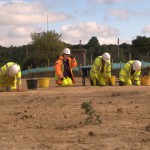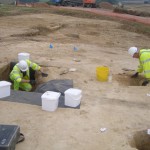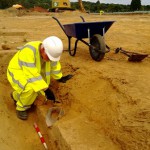 ARCHAEOLOGY enthusiasts working along the route of a new road have helped unearth what is thought to be one of the most significant finds of prehistoric remains in the country.
ARCHAEOLOGY enthusiasts working along the route of a new road have helped unearth what is thought to be one of the most significant finds of prehistoric remains in the country.
Working alongside Oxford Archaeology, members of the Hastings Area Archaeological Research Group (HAARG) have been involved in the excavation of Mesolithic flint scatters from the Bexhill to Hastings Link Road site.
This is just one of many finds uncovered since HAARG were given the unique opportunity to join the experts a year ago.
Lynn Cornwell from the Hastings Area Archaeological Research Group (HAARG) said: “This has been a unique opportunity to add to our knowledge of the area and has been a fantastic way of learning more both about archaeological techniques and about the history of this part of East Sussex.
“It has also given our members the chance to work alongside professional archaeologists and gain experience in enhanced excavation and recording techniques. We would like to thank East Sussex County Council and Oxford Archaeology for their support and encouragement.”
John Bothroyd from Oxford Archaeology added: “HAARG volunteers have become valued members of Oxford’s team, with their excellent local knowledge and enthusiasm being most welcome.”
 At the eastern end of the link road, near Upper Wilting Farm, the team has uncovered evidence of Early Romano British industry and Saxon Settlement activity.
At the eastern end of the link road, near Upper Wilting Farm, the team has uncovered evidence of Early Romano British industry and Saxon Settlement activity.
The main focus of Oxford Archaeology’s work in this area has been the excavation of a large iron working site with up to 17 iron smelting furnaces and evidence of associated activities.
HAARG volunteers helped in the excavation of platforms for ore roasting, an essential part of the iron production process. Members of the HAARG team excavated a near complete cooking pot, which provides valuable evidence to be able to date activity on the site.
Evidence of Saxon corn production has also been identified in the form of three unusual corn driers and a suspected barn. The HAARG team helped excavate the building in foul weather conditions and this led to the successful completion of some very valuable archaeological work.
County Archaeologist, Casper Johnson, said: “The Link Road is providing an opportunity to significantly increase our understanding of the archaeology and history of this part of East Sussex in an area which has seen relatively little large scale archaeological work and where there are major gaps in our understanding.”
Bob Pape, project manager for East Sussex County Council on the Bexhill to Hastings Link Road project, added: “We were delighted to be able to help our local archaeologist to work alongside the team from Oxford to uncover some of the hidden history of the Coombe Haven valley.”
The new link road will help bring 2,000 new homes, 3,000 new jobs and more than £1 billion of economic benefits to the area. It will also relieve the high level of traffic congestion on the A259 between the two towns.
Hastings Area Archaeological Research Group (HAARG) was founded in 1972 to enable those with an interest in local archaeology and history to take an active part in discovering and recording the district’s past.
Anyone wanting to find out more about HAARG can find details at www.haarg.org.uk


